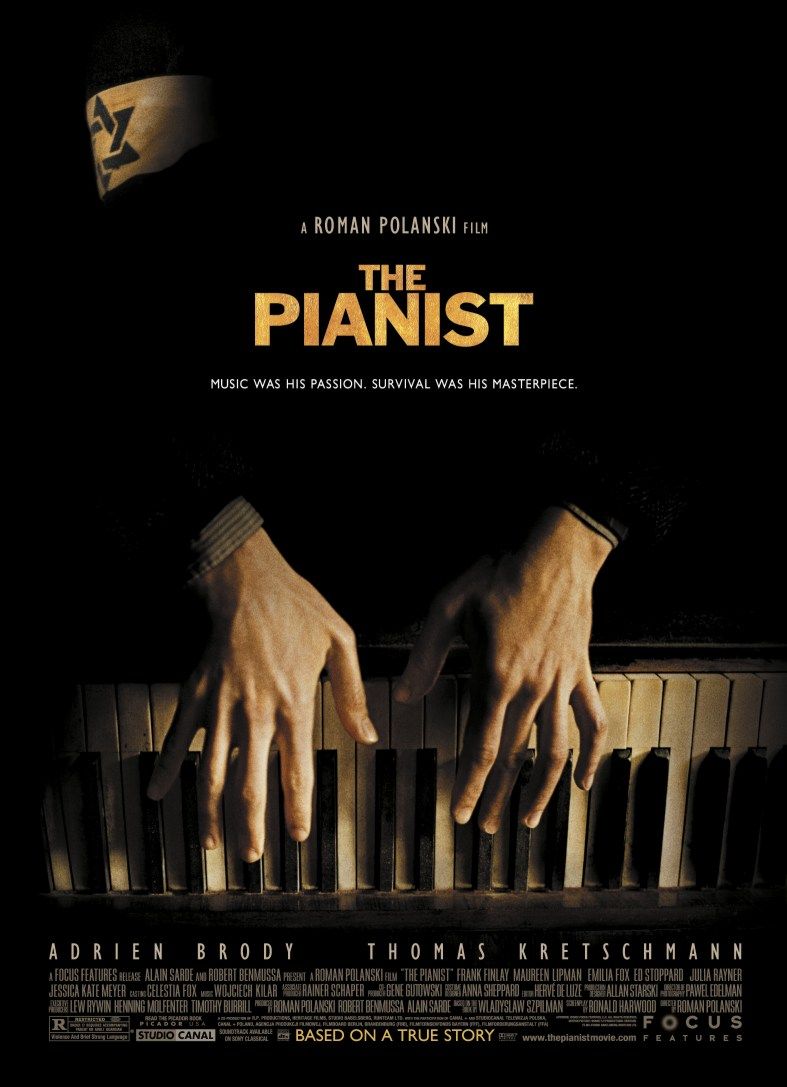Introduction:
Released in 2002 and directed by Roman Polanski, “The Pianist” is a cinematic masterpiece that weaves a harrowing tale of survival during the Holocaust. Adapted from the autobiography of Władysław Szpilman, a Polish-Jewish pianist, the film explores the indomitable human spirit in the face of unimaginable adversity. This comprehensive review aims to delve into the various facets of “The Pianist,” including its narrative brilliance, poignant performances, visual aesthetics, thematic depth, and the impact it has had on the war and thriller genres.
I. Narrative Brilliance:
- Historical Authenticity: “The Pianist” is anchored in historical authenticity, recounting the real-life experiences of Szpilman in Nazi-occupied Warsaw. The film meticulously depicts the gradual deterioration of the Jewish community and the impact of the Holocaust on individual lives.
- Intimate and Personal Perspective: The film adopts an intimate and personal perspective, following Szpilman’s journey from pre-war prosperity to the harsh realities of the Warsaw Ghetto. This narrative approach allows for a deep emotional connection with the protagonist’s struggle for survival.
II. Poignant Performances:
- Adrien Brody’s Oscar-Winning Performance: Adrien Brody delivers a tour-de-force performance as Władysław Szpilman. His portrayal earned him the Academy Award for Best Actor, making him the youngest actor to win the prestigious accolade at the time. Brody’s nuanced performance captures the vulnerability, resilience, and humanity of Szpilman.
- Supporting Cast Excellence: The supporting cast, including Thomas Kretschmann, Emilia Fox, and Frank Finlay, complements Brody’s performance with authenticity and emotional depth. The ensemble cast contributes to the film’s immersive storytelling, portraying characters with nuance and empathy.
III. Visual Aesthetics:
- Cinematic Realism: Cinematographer Paweł Edelman’s work in “The Pianist” is marked by cinematic realism. The film’s visual style reflects the bleakness of war-torn Warsaw, with muted colors and a documentary-like approach that enhances the sense of historical authenticity.
- Evocative Set Design: The set design, led by Allan Starski, recreates the stark and haunting landscapes of war-ravaged Warsaw. From the claustrophobic conditions of the ghetto to the desolation of abandoned buildings, the film’s visuals contribute to the atmospheric storytelling.
IV. Thematic Depth:
- Resilience and Survival: “The Pianist” delves into the themes of resilience and survival against all odds. Szpilman’s journey becomes a testament to the human spirit’s ability to endure even in the face of dehumanization, loss, and the constant threat of death.
- Loss and Isolation: The film explores the profound sense of loss and isolation experienced by Szpilman as he witnesses the destruction of his world. Themes of loneliness and the struggle to maintain one’s humanity in the midst of inhumanity are poignantly portrayed.
V. Emotional Impact:
- Powerful Score: The film’s score, composed by Wojciech Kilar, is a powerful element that enhances its emotional impact. The haunting and evocative music serves as a poignant backdrop to Szpilman’s journey, intensifying the emotional resonance of key scenes.
- Unflinching Portrayal: “The Pianist” does not shy away from depicting the brutality and atrocities of the Holocaust. The unflinching portrayal of historical events contributes to the film’s emotional impact, creating an immersive experience that elicits empathy and reflection.
VI. Awards and Critical Acclaim:
- Academy Award Success: “The Pianist” received critical acclaim and won three Academy Awards, including Best Director for Roman Polanski and Best Adapted Screenplay for Ronald Harwood. The film’s success at the Oscars solidified its place as a cinematic masterpiece.
- Global Recognition: The film garnered widespread recognition at international film festivals and received numerous accolades from critics. Its global impact extended beyond its artistic achievements, sparking discussions on the Holocaust and the resilience of the human spirit.
VII. Impact on War and Thriller Genres:
- Holocaust Representation: “The Pianist” stands as a significant contribution to Holocaust cinema, providing a nuanced and personal perspective on the wartime experiences of a survivor. The film’s impact has influenced subsequent filmmakers to approach historical narratives with sensitivity and authenticity.
- Thriller Elements: While rooted in the war genre, “The Pianist” incorporates thriller elements as Szpilman navigates the dangers of the ghetto and evades capture. The film’s suspenseful sequences add an extra layer of tension to the narrative, creating a blend of genres that captivates audiences.
VIII. Ethical and Moral Questions:
- Moral Dilemmas of Survival: “The Pianist” raises profound moral questions about the choices individuals make in extreme circumstances to survive. Szpilman’s moral dilemmas, including acts of desperation and collaboration, prompt viewers to contemplate the ethical complexities of survival during wartime.
- Witness to History: The film positions the audience as witnesses to a critical period in history, emphasizing the importance of preserving and remembering the stories of Holocaust survivors. It becomes a powerful tool for education and remembrance, urging viewers to confront the atrocities of the past.
Conclusion:
“The Pianist” is a haunting and evocative exploration of one man’s struggle for survival amidst the horrors of the Holocaust. Through its narrative brilliance, poignant performances, visual aesthetics, and thematic depth, the film transcends the war and thriller genres, leaving an indelible mark on cinematic history. Roman Polanski’s directorial vision, coupled with Adrien Brody’s unforgettable performance, crafts a symphony of survival that resonates long after the credits roll. “The Pianist” stands as a cinematic triumph that not only honors the resilience of Władysław Szpilman but also serves as a testament to the enduring power of storytelling in capturing the complexities of the human experience in times of unimaginable adversity.
